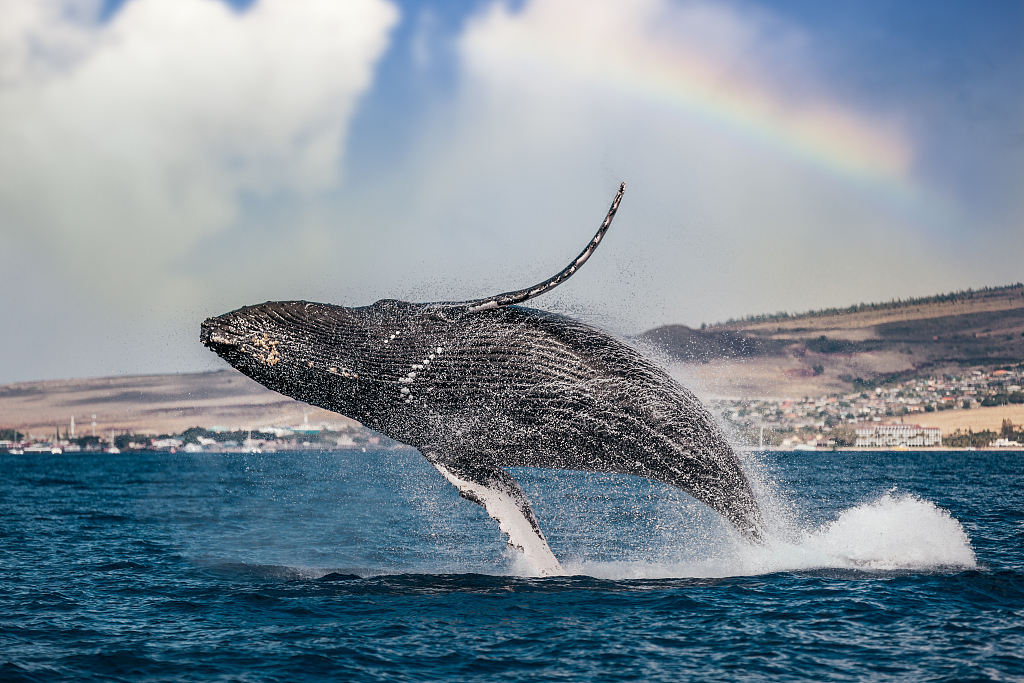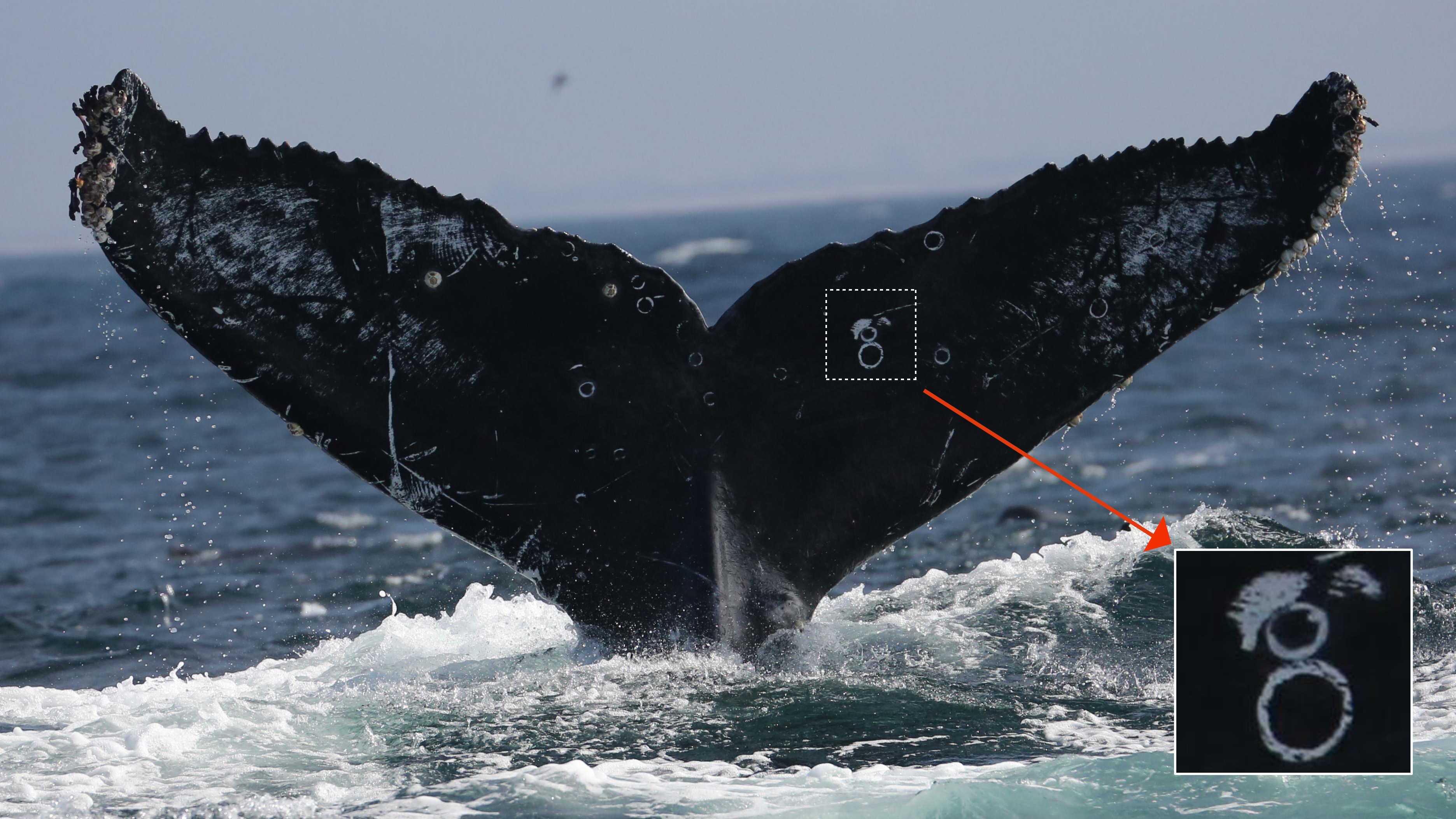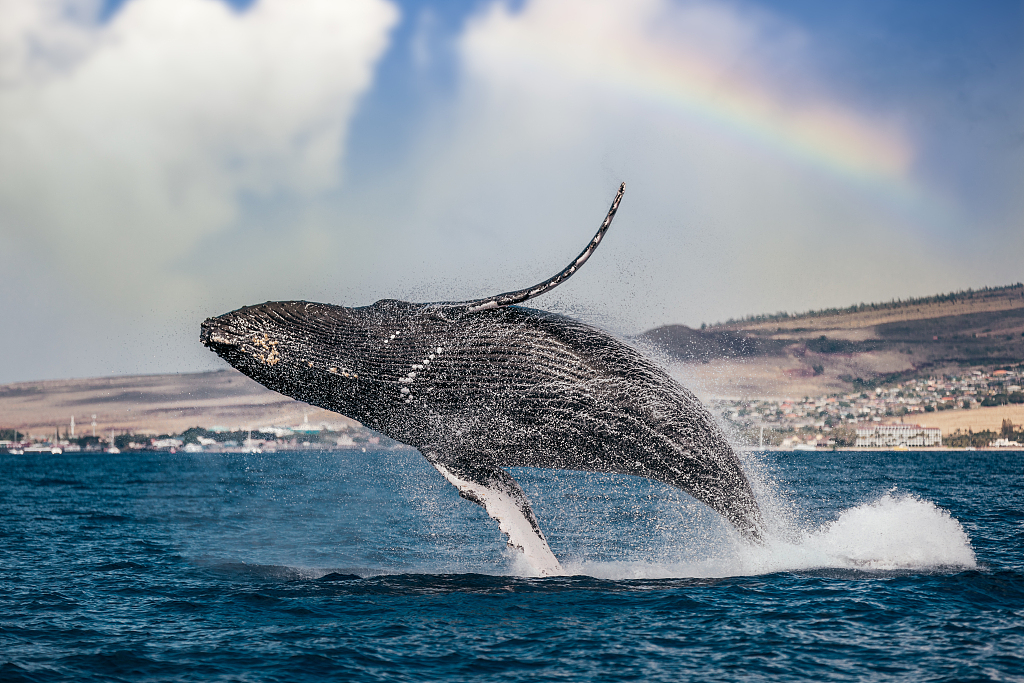Humpback whales, giant majestic mammals living in all oceans around the world, dive underwater for as long as 30 minutes before they surface for a breath, giving scientists a short window to observe them, not through their faces but their tails.
 A humpback whale. /CFP
A humpback whale. /CFP
A humpback whale. /CFP
“That little set of barnacle scars looked like a snowman, so we named it ‘Frosty,'” said whale researcher Ted Cheeseman while showing CGTN the following picture during an interview.
 Frosty, a humpback whale known from the west coast of the United States and Mexico. Humpback whale tails display unique pattern and shape allowing researchers to use AI image recognition to track thousands of whales. /Ted Cheeseman
Frosty, a humpback whale known from the west coast of the United States and Mexico. Humpback whale tails display unique pattern and shape allowing researchers to use AI image recognition to track thousands of whales. /Ted Cheeseman
Frosty, a humpback whale known from the west coast of the United States and Mexico. Humpback whale tails display unique pattern and shape allowing researchers to use AI image recognition to track thousands of whales. /Ted Cheeseman
 Whale researcher Ted Cheeseman shows a picture of humpback whale named Frosty during an interview with CGTN. /CGTN
Whale researcher Ted Cheeseman shows a picture of humpback whale named Frosty during an interview with CGTN. /CGTN
Whale researcher Ted Cheeseman shows a picture of humpback whale named Frosty during an interview with CGTN. /CGTN
“They all have these individually recognizable tails,” Cheeseman said of the whale that could weigh over 40 tonnes and is named for the distinctive hump on its back.
For decades, scientists have been collecting humpback whale tail pictures and distinguish each individual through a set of features: the shapes along the edges, the unique patterns left by barnacle scars, etc.
 Illustration of a humpback whale tail. /CGTN
Illustration of a humpback whale tail. /CGTN
Illustration of a humpback whale tail. /CGTN
But when the pictures pile up into the tens of thousands, they could bewilder even the sharpest eyes.
“Once the data sets got so big, it would take an hour per photo almost to figure out,” Cheeseman said.
That’s where AI fits into the picture.
Cheeseman and a group of whale scientists have been using AI photo recognition technologies through the website Happywhale.com, which Cheeseman co-founded, to record each humpback whale living in the North Pacific Ocean.
Researchers, citizen scientists and whale watchers are encouraged to upload whale photos upon a sighting into the database.
 A photo composite showing an uploaded picture of a humpback whale named Frosty on the left and a match result found on Happywhale.com on the right. /Ted Cheeseman
A photo composite showing an uploaded picture of a humpback whale named Frosty on the left and a match result found on Happywhale.com on the right. /Ted Cheeseman
A photo composite showing an uploaded picture of a humpback whale named Frosty on the left and a match result found on Happywhale.com on the right. /Ted Cheeseman
Early AI integration teething pains
However, the process was not easy, as researchers had to start with an algorithm with only a 10 percent recognition rate. Eventually, with the help of AI training, that rate has reached 97-99 percent, which “is higher than most trained humans,” according to Cheeseman.
“The technology evolves. It’s become much easier to train. It’s become capable to do so with much smaller data sets with much easy, much more user-friendly tools. I find it very exciting,” the whale researcher said.
The upgraded algorithm enabled Cheeseman and other researchers to make an important discovery regarding the humpback whale population. Nearly 7,000, or 20 percent of the humpback whales in the North Pacific Ocean, died between 2012 and 2021 due to the impact of marine heatwaves, according to their study published in late February by the journal Royal Society Open Science.
However, according to Cheeseman, despite the decline, the species’ population is still recovering after commercial whaling was banned in 1986 when many whale species were driven to the brink of extinction.
“I don’t think it’s a threat to the species …The population having recovered to, we estimate, 33,000 whales and then declining 20 percent, well, that’s severe, but it’s already on a recovery track,” said Cheeseman.
Still, researchers are concerned about the impact of climate change, particularly how future marine heatwaves could harm marine mammals.
A marine heatwave could have sweeping impacts on the ecosystem, from phytoplankton lacking nutrients all the way up the food chain to whales, sea lions and sea birds facing food shortages.
“It would have been through impacts on prey density,” John Calambokidis, a biologist and co-founder of Cascadia Research Collective, a field research nonprofit organization, told CGTN.
“A heatwave today maybe the average temperature of the oceans in future times, whether that’s 20 years or 50 years and then a heatwave from there would be absolutely inhospitable to whole populations (of humpback whales),” Cheeseman said.
Researchers now hope that the system could be used to study the global population of humpback whales and other cetaceans in the world’s oceans.
(Cover: A breaching humpback whale in Nayarit, Mexico. /Nicola Ransome)
